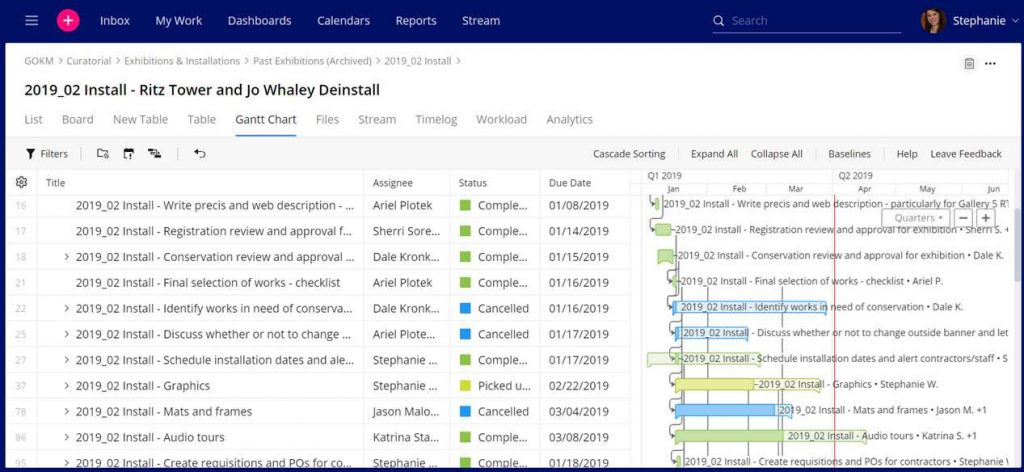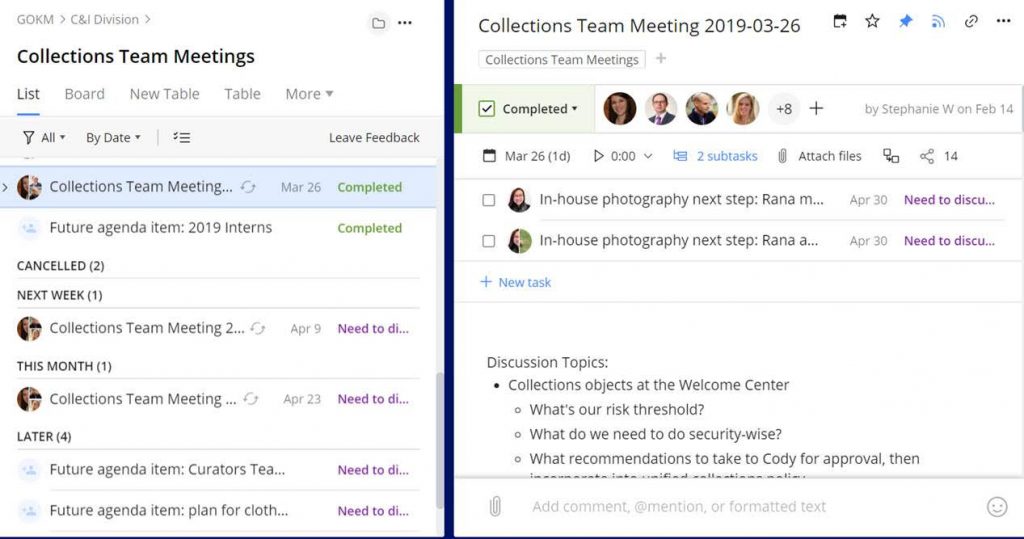Written by Stephanie Wilson
Project Manager, Collections and Interpretation. Georgia O’Keeffe Museum
Every day, museums work on projects that require multiple people and resources to work together on a series of tasks to achieve a goal. Digital project management tools can streamline your team’s work, increasing transparency, accountability, and communication. But how do these tools do this? Digital project management tools are online-based interfaces that can:
- Maintain a shared to-do list
- Show who is assigned to a
particular task, when it’s due, and when it’s completed - Centralize communications
- Send automated notifications
- Provide a searchable record
- Display a project’s tasks and
work in multiple ways, like spreadsheets, calendars, task lists, and timelines
or Gantt charts
A cursory search online will show there are many digital project management tools out there. They all provide a shared workspace for your team to track project work, with varying user interfaces experiences. The Georgia O’Keeffe Museum in Santa Fe, New Mexico uses Wrike.

I work on the Collections and Interpretation team, which consists of Curatorial, Education and Interpretation, Research Collections and Services, and Historic Properties, the Museum owns both of O’Keeffe’s homes and studios in Northern New Mexico. My team is frequently spread out to support our travelling exhibitions and loans, and we are physically in different buildings on our campus. We use Wrike to help us juggle our different projects, maintaining clear communications and accountability. We leverage automated reminders and shared to-do lists to not feel like we are constantly forgetting something. In addition to Wrike, we use Dropbox to manage our files and Zapier to automate a few actions between Dropbox and Wrike.
While the O’Keeffe’s Curatorial team started using Wrike in 2013, it struggled to make it stick. I was hired as Curatorial Project Coordinator in 2016, and charged with building system use and buy-in. Since 2016, we have gone from 6 users to 45, spreading the joys of Wrike beyond the Collections and Interpretation team to other departments within the Museum.
So why did it take so long to make it stick?
Adding a digital project management tool is not easy. Everyone manages their time and work differently, and such tools are workflow disruptors. There is a steep learning curve, it is an extra step to check the online interface on a daily basis, teams must agree to actually use the tool and how and where they are sorting information, and, unless you edit your notification settings right away, the tool will overwhelm your email inbox. So why bother?

For the O’Keeffe, Wrike saves us time and energy. It is our source of truth. It helps us centralize communications through comments, rather than long email chains, and it is easy for everyone to see exactly what is going on in a project. Here are a few strategies and lessons learned from building Wrike buy-in at the O’Keeffe:
- Identify a system champion. This person doesn’t have to be a “Project Manager” by title, they just need to take the time to set up a project in the system and learn what works best for the team. This person should guide team usage and identify how information is best sorted. The system champion should host frequent individual and group training sessions to get everyone on the same page. This person should also use the tool’s help files and blogs to identify new ways to use the tool better and get team members excited about using the system.
- Work with the workflow disruptor by finding ways to push the team to the system every day. For the O’Keeffe, we hold all meeting agendas and notes in Wrike. We have also set the expectation that team members check the tool daily and bring their computers to meetings.
- Reduce “noise” and jargon. Project management systems tend to overload users with notifications about changes to tasks – dial those back or team members will eventually ignore the many email reminders, making the automation pointless. These systems can also get pretty jargon heavy – take the time to clarify with your team the difference between a “task,” “folder,” and “project” to save time and energy when it comes to sorting and finding project information.
- Don’t replace face-to-face communications. Everyone communicates differently; your tool should never replace fluid, brainstorming sessions and problem-solving conversations. This is also a way for the system champion to check in on how team members are (or are not) using the tool.
- Manage expectations and be patient. It will take time to learn what works best for the team, and the learning curve is steep. Remind the team that it’s perfectly normal for it to take a few months for it to stick and that’s okay. As long as everyone continues to use the tool, it will get easier and the benefits of keeping everything in one place will show.
- It’s not magic! Make sure people know that! People tend to think once they start using a system it will fix all their problems. A tool is only as good as the people using it – they need to actually check it daily, and not use it as the only form of communication.
I have refined these strategies and learned these lessons over the last three years, and continue to learn based on the needs of my ever-growing team. While managing Wrike takes time and daily upkeep, it is well worth it and I love that it is part of my role at the O’Keeffe. It has expanded our capacity, reduced run-around, and helps my team work smarter, not harder to fulfil our Museum’s mission. It is my hope that someday digital project management tools become as normal as Outlook or Gmail for all museums because it is the path to more efficient teams, stronger projects, and better museum exhibits and programming for all visitors.
Stephanie Wilson was the Project Manager, Collections and Interpretation for the Georgia O’Keeffe Museum in Santa Fe, New Mexico.